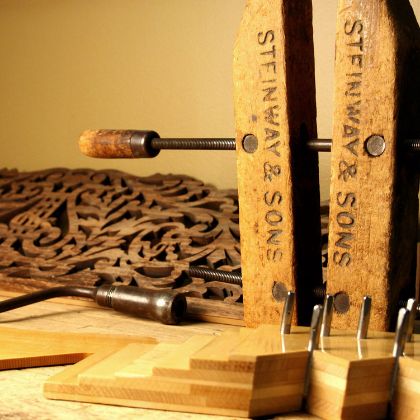On restoring a steinway
Paul McCartney and Berry Gordy attend the Motown Museum Announces Project at steinway hall.
It was a shopworn part of living history that graciously gave all it had to help define a distinctively American musical genre, the sounds of which echoed across the pond to profoundly influence four lads from Liverpool.
In the summer of 2011, when Paul McCartney went to sit behind an 1877 Steinway grand piano at the Motown Museum in Detroit, it came as no surprise there was little left in terms of recreating some vintage magic on the keys.
The former Beatle told museum officials he wished to aid in the restoration and then called on the Steinway & Sons factory in New York — the very place that handcrafted the nine-foot Victorian rosewood instrument over a century ago. Motown acquired the Steinway when it purchased Detroit’s Golden World Studio in 1967.
“Paul asked if we would be willing to partner with him in rebuilding this historic piano and we were of course very excited to get involved with such an extraordinary project,” says William Youse, Director of Technical Services and Special Projects at Steinway & Sons. The highly prized artifact was shipped from Motown to the Steinway Restoration Center.
“While the Museum did its absolute best to keep this instrument from deteriorating any further, they faced a daunting task,” Youse observes, adding that the piano had interventions that impacted the soundboard, strings, action and finish, and case.
“We learned that the piano was restrung in the 1960s, and the action was reworked on different occasions, along with several major repairs to the soundboard. There were parts from many different pianos that were used just to make it work,’’ Youse recalls.
At some point, the original rosewood finish was converted to black. Fancy legs from the factory were replaced, as well. “All very noble efforts but in their totality did not add up to a playable piano, never mind a Steinway,” Mr. Youse says.
Motown representatives toured the factory and restoration facility, where they had a chance to meet the skilled craftsmen who would be responsible for breathing new life into the piano.
Steinway artisans were told to replace everything to bring the instrument back to its authentic splendor, including the soundboard, keys, hammers, pins and strings, but they were also instructed to retain the original case.
Steinway & Sons opened the restoration facility more than twenty-five years ago, the only place in the western hemisphere where a Steinway & Sons piano can be returned to its resplendent beauty and performance standards while remaining a hundred percent Steinway.
“A Steinway piano is built to be rebuilt,” says Youse, “and restored. The average age of the Steinway we restore here is seventy-five. As old as a hundred thirty years old.”
“Quite frankly,” Youse continues, “when we’re done, they go back out into service. They don’t go back out to a museum or behind a velvet rope. They go out and get played on. For a complete restoration, we put in a soundboard, that’s the heart and soul of a piano, what gives the Steinway its volume, its sound. We’ll literally replace complete actions, what are called pinblocks or wrestplanks. When the tuner comes to tune your tuning pins, that’s what holds those in place. The cast iron harp gets stripped down, re-bronzed and refitted with all new hardware — stripped off, completely refinished, hand rubbed and polished. When that’s done, if we stand it next to a brand-new Steinway, we hope you can’t even tell the difference.”
“If you want it to be a Steinway, you bring it to Steinway and we make it a Steinway.”
With the Motown Museum piano, there was a documented history of the instrument. But what about piano owners who bring in their grandmother’s piano, where lineage and memory can be hazier?
“We ask them: ‘What do you remember about the piano?’” Youse suggests. “‘Was it a booming, big sound?’ ‘Was it a mellow sound?’ ‘What was the color of the piano?’ With certain woods, color changes over time. And then we invite them in with a technician and they go over the voicing. ‘I remember this being a bit lighter,’ and we’ll go back and lighten up the action. ‘I remember this being brighter’ or ‘more mellow’ and we’ll work on a small section of the keyboard and see if that’s the way they like it — and then expand it to the rest of the piano.”
Just as with the craftsmanship of a new Steinway, restoration is done by hand. “We replace rather than repair,” says Youse. “If a part is broken, we will replace it with a new one that works better than a repaired old one.”
All work performed at the Restoration Center is warranted by Steinway & Sons for the same term and conditions as a brand-new Steinway. “The most important reason to have your piano restored at the Steinway Restoration Center is that when we’re done, it will be a one-hundred-percent Steinway instrument. When you send it to someone else, it will just be their impression of what a Steinway is. A lot of what we do is proprietary, so they don’t know how our soundboards are constructed. Without our knowledge, expertise and technology, you can’t say that it is a true Steinway. If you want it to be a Steinway, you bring it to Steinway and we make it a Steinway.”
-

Steinway & Sons Restoration Center
Ensure that Your Piano Remains 100% Genuine Steinway.
learn more
Learn more about the Steinway & Sons Restoration center.